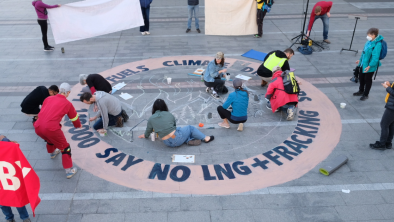Site C: A Shakespearean Tragedy of BC Politics
The Tyee

A review of the book Breaching the Peace by Victoria journalist Sarah Cox
Breaching the Peace: The Site C Dam and a Valley’s Stand Against Big Hydro
Sarah Cox
UBC Press (2018)
If Shakespeare had been a Canadian, he would have written plays about the tragedy of dams and their power-crazed political proponents.
King Lear, for example, would have championed the nasty works of his engineering offspring while ignoring the true love of his river-keeping daughter.
Meanwhile his tragic dam building ambitions would destroy forests and displace aboriginal people. Walls of concrete would dethrone the sacred, and an engineered world would introduce more fragility to the natural one.
Fisheries would be ruined and mercury would poison the living for generations — and all for the glory of ambitious politicians and their technical servants.
And that is why Sarah Cox’s book about the destructive Site C dam is such an elegant and infuriating piece of journalism.
It chronicles how urban Canadian politicians continue to assault a critical river valley and why people in Treaty 8 country continue to resist what can only be described as a relentless form of state-sanctioned tyranny.
Over the last three years Cox, a Victoria-based reporter, travelled throughout Peace River country — a temperate and highly diverse Amazon — and talked to its local communities including ranchers, farmers, trappers and First Nations.
She quickly surmised that these hardy people knew a lot about BC Hydro and its legacy of lies.
In particular, the people of the Peace had witnessed how two previous dams championed by then-premier W.A.C. Bennett had eroded the region’s health for the colonial benefit of city dwellers who live 14 hours away.
She discovered that their abiding resistance to Big Hydro, perhaps one of the most corrupt forces in the province, was based on historical experience. People in the Peace also understand the profound tragedy playing out in political circles better than any Vancouver media outlet.
And this is what makes the Site C megaproject and this book so maddening: even when there is no demonstrable economic need for the project and even when cheaper alternatives exist, politicians continue to champion a $11-billion megaproject that could bankrupt the province. How Shakespearean is that?
The basic cruelties laid out by Cox, and all in dispassionate prose, would probably have upset the old Bard himself or provoked a bleak sonnet.
For nearly 50 years now politicians and engineers have dreamed of planting a third dam on the mighty Peace River. However, economics and science rudely curbed their technical ambitions, says Cox. In 1983, the BC Utilities Commission, for example, flatly dismissed Site C as a ruinous idea. Moreover, it found that the province didn’t need additional electrical power and if it did, geothermal could provide better options. In addition, the commission concluded that the dam would have destroyed too many human, historic and natural communities in one of Canada’s most fertile river valleys.
In the 1990s, Marc Eliesen, then BC Hydro’s president and CEO, reviewed the evidence and rejected the scheme again as a fiscal and environmental nightmare for the province. These truths, however, didn’t deter former premier Christy Clark, our own Lady Macbeth.
She simply created her own fake emergency and said the province now needed the dam “to keep the lights on.” (It doesn’t take much to manipulate or scare city dwellers.) She also passed laws to prevent any real evidence from being considered and to evade accountability.
Her political cronies such as Brad Bennett, then the chair of BC Hydro’s board of directors, warned citizens to be on the lookout for fake news about the project.
“I take issue with the fake news crowd, talking about Site C and whether it is needed or not,” said Bennett in 2017 — long before Trump turned the phrase into an Orwellian chant.
The residents of the valley, however, never bought this government propaganda. Consider Mark Meiers, a local farmer. In 2015 he blocked a dam construction site with his truck and was one of the first arrested for protesting the megaproject.
“We’re ordinary people,” he later explained to a RCMP officer. “Ordinary people that you never see in your course of duties. And you have to ask yourself, ‘Why are these people out there doing this?’”
BC Hydro inadvertently answered that question when it sued a small group of winter protesters for “irreparable harm” alleging that their protests could cost the agency as much as $420 million. University of Victoria law professor Chris Tollefson told Cox that the SLAPP suit was simply outrageous: “he had never heard of a Crown corporation seeking damages from an individual for lawfully and peacefully exercising the right to protest on a matter of public interest.”
It is telling that the John Horgan government, another dam pusher, has not dropped the intimidating lawsuit against B.C. citizens.
Chief Roland Willson, another ordinary person, has also resisted the megaproject on behalf of West Moberly First Nation for a long time. It didn’t take Wilson long to realize that BC Hydro wasn’t interested in consultation let alone reconciliation.
When he asked BC Hydro to consider a geothermal plant or gas-fired plant to save his ancestral home, the Crown agency predictably replied that the dam was the only option, proving that technical determinism rules the day.
But West Moberly’s legal challenge, which will be heard this July, may well stop this bad project. It contends that Site C (and the two existing dams) have abrogated West Moberly’s constitutional rights to enjoy the land as promised by Treaty 8.
Towards the end of this brave book, Cox highlights the dam’s absurdity with a Dr. Seuss story about bull trout. The dam, of course, will block their way to their historic spawning grounds so BC Hydro came up with a crazy “mitigation strategy” — a plan that mirrors the whole project’s stupidity.
According to the strategy, technicians will lure the bull trout to a special entrance where they will find a fish ladder. The fish will then jump up to 10 vertical metres. Once trapped in a pool the fish will be anesthetized. A “mechanical fish lift” will take the trout to a sorting area.
Once counted and organized by species, the fish will be stored in aerated tanks. After a truck ride, more technicians will escort the trout by boat upstream to the Halfway River.
The program will cost $25 million to install and another $1.5 million each year to maintain for the life of the dam. A similar bullshit scheme was tried in Idaho and failed.
Cox’s book makes it plain that the dam, if citizens let it proceed, will impoverish every one of us. Site C, for example, will destroy enough farmland to supply one million people every year with fresh vegetables in an era where volatile climate change threatens global crop security.
The dam, too, will flood lands sacred to First Nations and turn Treaty 8 into another worthless piece of paper. It will rob taxpayers of more than $11 billion for high-cost electricity that can be provided by cheaper and alternative means with much less ecological destruction. And on it goes.
Years ago, the social critic and radical Christian Jacques Ellul wrote about dams and how they illustrated the corrosive power of technology. In an interview with Dutch filmmakers he explained what Cox unwittingly documents so well in her book: “Technology will not tolerate any judgment being passed on it. Or rather technologists do not easily tolerate people expressing an ethical or moral judgment on what they do.”
Ellul added that “the expression of ethical, moral and spiritual judgments is actually the highest freedom of mankind. So I am robbed of my highest freedom. Whatever I say about technology and the technologists themselves is of no importance to them. It won’t deter them from what they are doing. They are now set in their course. They are so conditioned. For a technologist is not free.”
Cox’s book is a damning reminder that Canadian politicians of all hues still practice a state-sanctioned tragedy: they murder rivers to serve their political ambitions, tolerate no dissent, consider no alternatives and then call the fiscal abomination “green energy.”
To see original article click here


